
In an era long past, colossal reptiles dominated the globe, from the fearsome Tyrannosaurus rex with its daunting jaws to the long-necked Diplodocus, showcasing an astonishing diversity of dinosaurs that once inhabited our planet. The feat that every six-year-old seems capable of achieving — mastering the complex Latin names of these ancient beasts — is almost as remarkable as the variety itself. Alas, the reign of the dinosaurs came to an abrupt halt 66 million years ago, courtesy of a cataclysmic asteroid impact, marking a fortuitous turn of events for mammals. While a number of dinosaurs made a transformative leap into avian species, the vast majority of these immense prehistoric creatures met with extinction.
But did all of them vanish? In the realms of cryptozoology, there are those who believe that dinosaurs might still tread our Earth, hidden in the depths of Loch Ness or the vast expanses of the Australian Outback. It’s important to note, however, that there is no solid, confirmable evidence to back the existence of these creatures outside of the fictional world of Jurassic Park movies. Yet, the myths endure, likely fueled by the captivating notion that dinosaurs might still roam among us in the modern age
SAY HELLO TO THE LAST BRONTOSAURUS IN THE WORLD
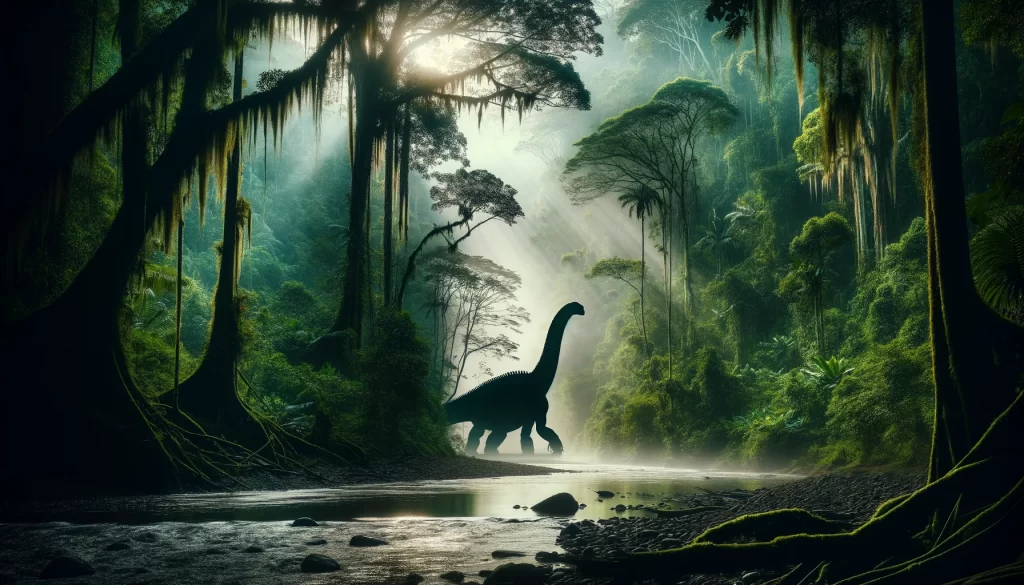
Deep within the lush rainforests of the Democratic Republic of the Congo, a legend persists about an elusive creature of monumental size, known as Mokele-mbembe. This term, originating from the Lingala dialect, translates to “one who stops the flow of rivers,” as noted by explorer Herman A. Regusters. Described as being 35 feet in length, with a long neck and grayish skin, Mokele-mbembe is said to bear a striking resemblance to the Brontosaurus. Contrary to its dinosaur counterpart, however, reports suggest that this creature is far from a harmless herbivore, purportedly preying on crocodiles, hippos, and even elephants upon its emergence from the riverbanks.
The intrigue surrounding a living Brontosaurus within the Congo dates back well over a century, with the earliest documented mention appearing in the 1909 publication “Beasts and Men” by Carl Hagenbeck. Hagenbeck, a zoologist known for his showmanship, embarked on an expedition to uncover this creature, though he returned empty-handed. Despite this, his belief in Mokele-mbembe’s existence remained unwavering.
In more recent times, the search for Mokele-mbembe was reignited by the “Newmac Expedition,” an initiative funded through a Kickstarter campaign led by a group of ambitious yet inexperienced adventurers. Managing to secure almost $28,000, the team, led by Stephen McCullah, aimed to capture the mythical beast alive using tranquilizer rifles—a plan that might have benefited from watching Spielberg’s “The Lost World.” Despite their high hopes and considerable public interest, the expedition ultimately did not succeed in its quest, as reported by the Sun-Sentinel.
IOWA GETS VISITED BY A PTEROSAUR
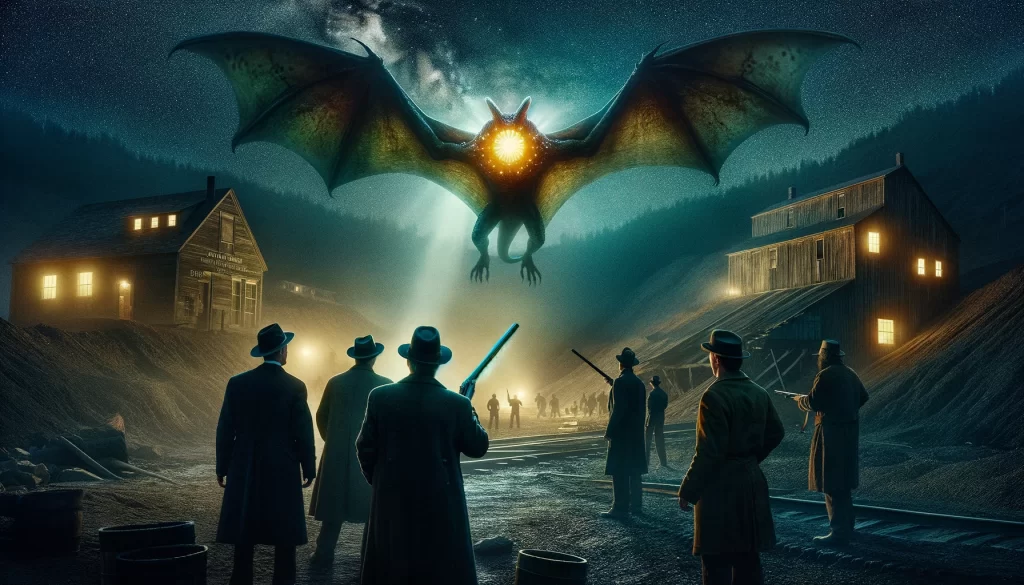
In the quiet expanse of Iowa, far from the typical locales associated with prehistoric creatures, lies a tale that blurs the line between legend and the uncanny: the legend of the Van Meter Visitor. This peculiar narrative unfolds in 1903, as documented by The Des Moines Register, in the small, unsuspecting town of Van Meter. Here, a series of eerie encounters left an indelible mark on the town’s history, involving several of its most esteemed citizens.
These prominent individuals reported sightings of a fearsome creature, described as a flying reptile with bat-like wings, leaving behind three-toed tracks and an unsettling odor in its wake. Adding to its enigmatic nature was a bizarre detail — a glowing light emanating from its forehead, a characteristic that defies easy explanation. In an era when supernatural explanations were more readily accepted, this creature quickly became the focus of local dread.
Determined to confront this nocturnal terror, a group of men, armed with shotguns and fueled by a mix of fear and resolve, formed a posse. Their venture led them to an abandoned coal mine, the purported lair of the Van Meter Visitor and, astonishingly, its offspring. The confrontation reached its climax when both creatures, rather than attacking, chose to retreat into the shadowy depths of the mine, disappearing from Van Meter and into the annals of legend.
The Van Meter Visitor’s tale might sound like the plot of a campy horror film, yet its significance is magnified by the credibility of its witnesses — respected community members with more to lose than gain by fabricating such a fantastical story. While no concrete evidence supports the existence of such a creature, the intrigue surrounding the event has endured, celebrated annually at the Van Meter Visitor Festival every September. This celebration keeps the story alive, inviting speculation, skepticism, and wonder in equal measure.
IS THERE A DINOSAUR STILL ALIVE IN PAPUA NEW GUINEA?
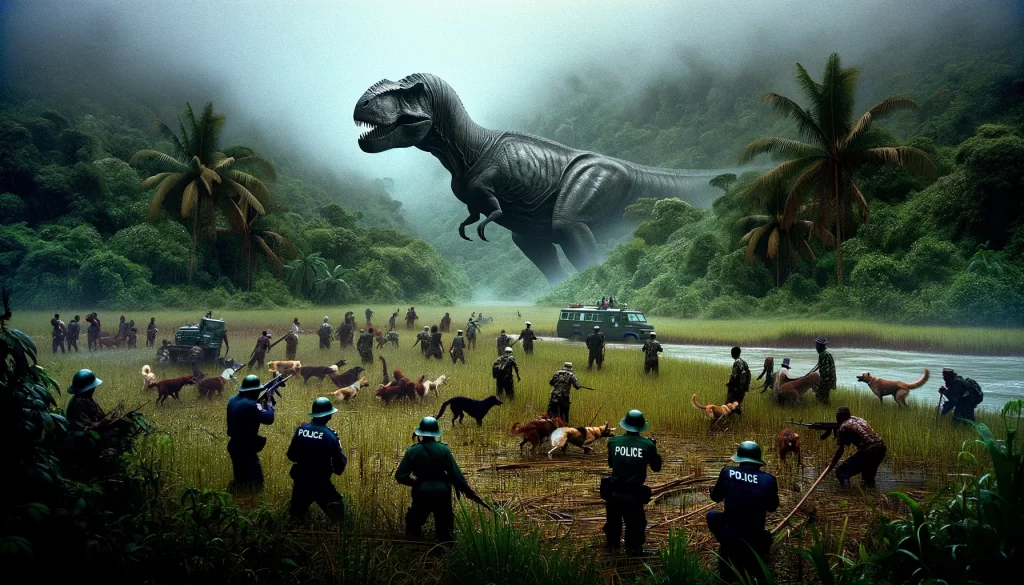
Imagine looking out your window to see a towering, Tyrannosaurus-like creature with gray skin and menacing sharp teeth, an encounter straight out of a prehistoric nightmare. This wasn’t a scene from a movie for some residents of Papua New Guinea in 2004; it was their reality. Reports flooded in about a massive beast that had allegedly attacked and devoured three dogs, a terrifying ordeal described by witness Christine Samei as an encounter with a “very huge and ugly looking animal.” In response to this alarming situation, villagers did what anyone would do when faced with a potential dinosaur on the loose—they called the police.
The law enforcement’s reaction was swift, with officers diving into the marshlands near Rabaul, a town previously devastated by a volcanic eruption in 1994, in search of the creature. Despite their efforts, the search yielded no evidence of the dinosaur’s existence. This outcome was a letdown, especially for Kokopo Mayor Albert Buanga, who saw the silver lining in having a living dinosaur as a local inhabitant; it could have been an unparalleled tourist attraction, offering a unique draw unlike any other.
This incident in Papua New Guinea isn’t an isolated tale of dinosaur sightings. The island is ripe with legends of the “ropen,” believed to be a surviving pterosaur. Although there have been attempts to capture this creature on film, purported videos of the ropen have been debunked, revealing the subjects to be nothing more than ordinary frigatebirds. While these birds may bear a passing resemblance to pterosaurs to the imaginative eye, the comparisons stop there. They’re far from being the next Godzilla antagonist, but their mistaken identity fuels the rich tapestry of local folklore and global fascination with prehistoric life persisting in the modern world.
A STEGOSAURUS IN THE CONGO?
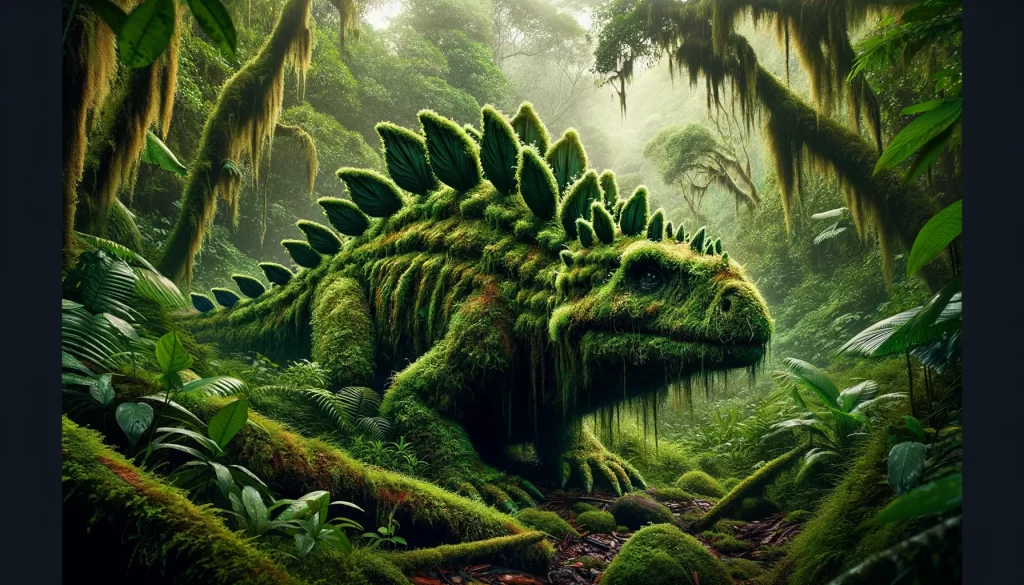
The Mbielu-mbielu-mbielu, despite its captivating name, remains one of the lesser-known cryptids purported to roam the Congo Basin, overshadowed by its more famous counterpart, Mokele-mbembe. This elusive creature, believed to share the same habitat, adds an intriguing layer to the already rich tapestry of African cryptid lore. The distinction of Mbielu-mbielu-mbielu lies not just in its name, but in the unique description attributed to it—a dinosaur with mossy spines protruding from its back, bearing a resemblance to the Stegosaurus, a dinosaur that stirs the imagination with its distinctive appearance.
The sparse evidence supporting the existence of Mbielu-mbielu-mbielu, as detailed in “Mysterious Creatures: A Guide to Cryptozoology,” stems from a single account relayed to Roy P. Mackal during his expeditions in the 1980s to locate Mokele-mbembe. Mackal’s encounter with Odette Gesonget, who shared a secondhand tale from her parents witnessing this living dinosaur, underscores the enigmatic nature of cryptid research—a field often mired in anecdotes and hearsay. While the allure of discovering a living Stegosaurus cryptid is undeniable, the lack of substantial evidence places Mbielu-mbielu-mbielu firmly in the realm of cryptozoological curiosities, a testament to the enduring human fascination with the possibility of prehistoric life surviving in the modern era.
This narrative, teetering on the edge of folklore and scientific curiosity, encapsulates the challenges faced in the pursuit of cryptids. The Mbielu-mbielu-mbielu, with its intriguing description and sparse anecdotal evidence, remains a captivating subject for those drawn to the mysteries of our planet’s unexplored territories, reminding us of the vast unknowns that persist in the natural world.
RAPTORS RUNNING AROUND IN SOUTH AMERICA
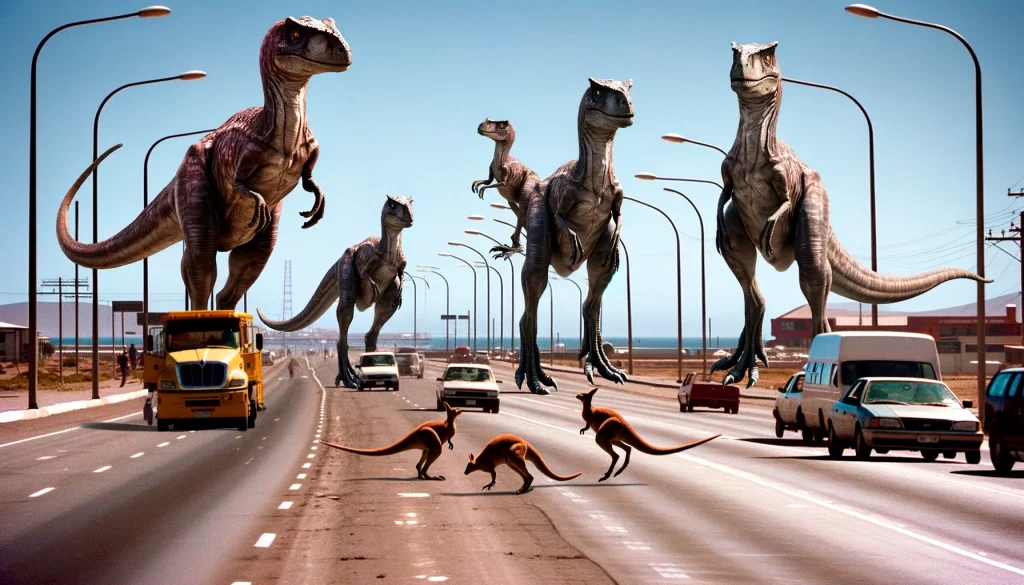
The streets of Arica, Chile, became the backdrop for an extraordinary tale in 2004, as reported by the Chilean newspaper El Mercurio. Witnesses in two separate vehicles encountered what appeared to be dinosaurs, specifically resembling the Velociraptors popularized by Jurassic Park, except these creatures were standing smack in the middle of the road. Towering at an imposing height of six feet and displaying an unexpected mode of escape by hopping away like kangaroos, these “dinosaurs” certainly left an indelible mark on those who saw them. Among the witnesses was an Army recruitment officer, Hernán Cuevas, whose daughter’s scream at the sight of the creatures encapsulated the shock and awe such an encounter would naturally elicit.
This peculiar sighting spread through various South American newspapers, sparking intrigue and speculation far beyond the confines of Arica. However, despite the initial buzz, the so-called “Arica raptors” vanished as mysteriously as they appeared, leaving behind a trail of questions and theories, including whimsical suggestions of time-traveling reptilians.
The notion that these creatures were Velociraptors, as initially thought, was quickly scrutinized. Smithsonian.com clarifies that actual Velociraptors were much smaller than their cinematic counterparts, reaching only up to a human’s waist. The dinosaurs depicted in Jurassic Park, which more closely match the description of the Arica sighting, would better align with Deinonychus, a larger species. This mix-up highlights the often-blurred lines between Hollywood’s dramatic portrayals and paleontological reality, reminding us of the need for accuracy in our representation of the prehistoric past.
SOME SAY THERE’S A T-REX STILL ALIVE IN AUSTRALIA
Honestly? If you had to place bets regarding where on Earth you’d be most likely to find a Tyrannosaurus rex chasing after your Jeep, the Australian Outback would probably have the best odds. That beast would fit right in with the thorny devils and platypuses, that’s for sure.
So it’s really no surprise that one of Australia’s local dino legends is the Burrunjor, a roaring predator that’s somehow big enough to devour livestock, while also being sneaky enough to avoid any photographs in the age of iPhones. Or, you know, footprints. Stories of the Burrunjor are alleged to have begun with Aboriginal mythology, but proper sources on this factoid are hard to come by. In recent years, the cryptid seems to have dropped off the radar, with the last supposed “sighting” happening in 1985. Good luck finding a report of this encounter without falling into one of those typical “he said/she said” wormholes.
Nonetheless, while evidence to support the Burrunjor’s existence is quite flimsy, the notion of a T-Rex living in Australia is entertaining enough to continue inspiring books on the subject to this day. Maybe someday, the Discovery Channel will do one of those weird mockumentaries about it.
IS IT A THUNDERBIRD, A PTERODACTYL, OR A BIG HOAX?
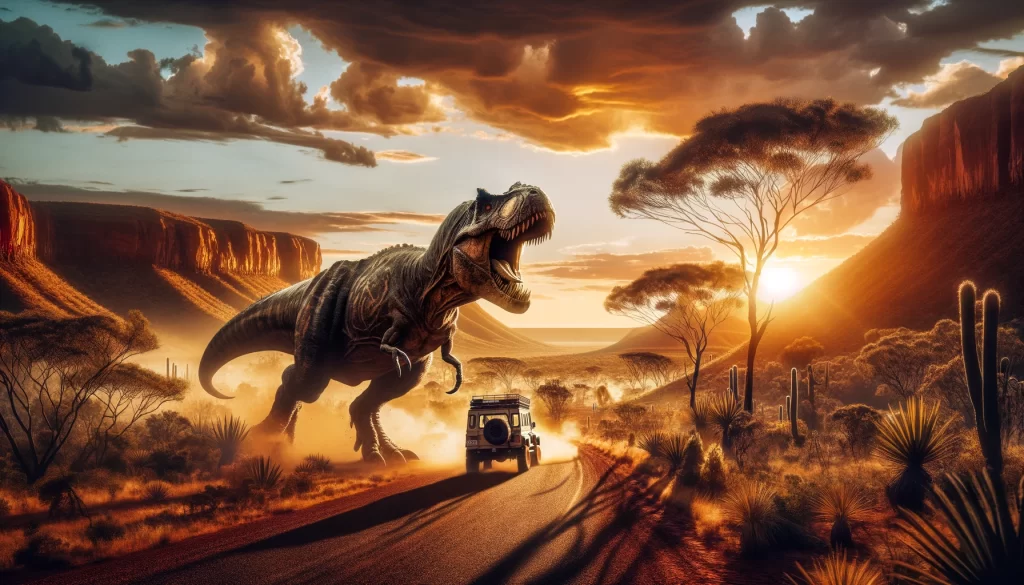
The Australian Outback, a land teeming with creatures both fascinating and fearsome, might just be the place you’d expect to encounter a scene straight out of a prehistoric epic—a Tyrannosaurus rex in hot pursuit of your Jeep. In this rugged terrain, where thorny devils and platypuses roam, the idea doesn’t seem too far-fetched. This setting is also home to one of Australia’s own cryptic legends: the Burrunjor.
The Burrunjor is described as a formidable predator, capable of consuming livestock yet elusive enough to dodge the ever-watchful eye of modern technology—no photographs, no footprints, nothing. This creature’s origins are said to trace back to Aboriginal mythology, although concrete details and sources to substantiate these claims are scarce. Despite the intrigue surrounding it, the Burrunjor has seemingly vanished from the public eye, with the last reported sighting dating back to 1985. These accounts often lead down the rabbit hole of anecdotal evidence, making the truth even harder to pin down.
Yet, the allure of a living T-Rex in the Australian wilderness remains undiminished, fueling the imagination of enthusiasts and skeptics alike. The concept has inspired books and might one day be the subject of a Discovery Channel mockumentary. The Burrunjor’s presence in cultural and cryptid lore, despite the lack of tangible evidence, speaks to the human fascination with the idea of prehistoric creatures surviving into the present day.
BEWARE THE BUNYIP
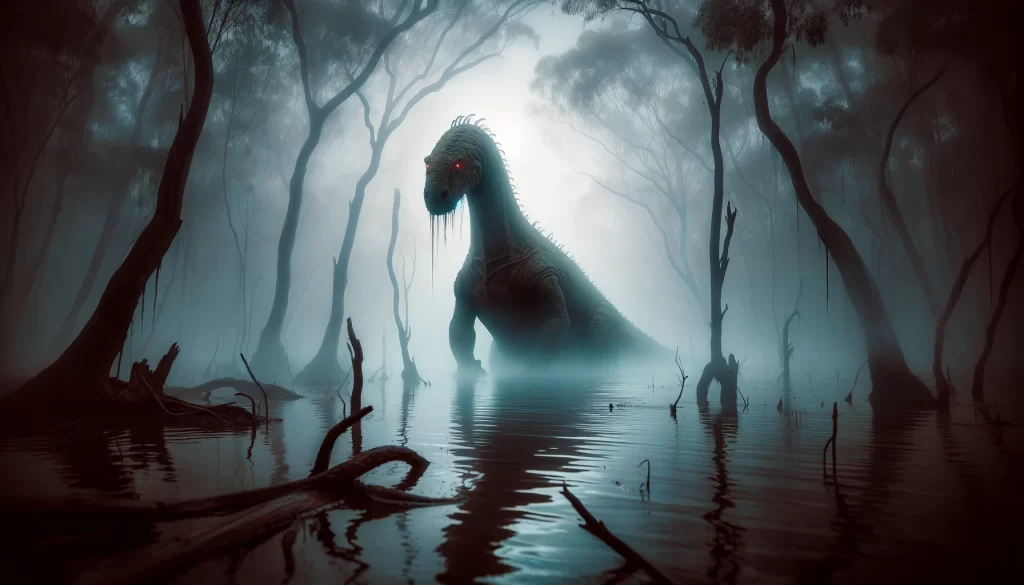
The Bunyip, a creature steeped in Australian Aboriginal mythology, stands as a captivating emblem of the continent’s rich folklore. Described by some as a formidable “water spirit” lurking in the swamps, its reputation for emitting ominous booming noises and possessing a voracious appetite for humans, particularly women and children, paints a dark picture. The creature’s physical description often aligns with that of a sauropod dinosaur, featuring a long neck and a thick, hippo-like body, suggesting a being of considerable size and strength.
However, the Bunyip defies singular characterization. Its depiction varies wildly across stories, ranging from dinosaur-like behemoths to humanoid figures, each with its own set of terrifying attributes, such as big red eyes, sharp claws, or webbed hands. This variability extends to its behavior as well; while some narratives cast the Bunyip as a benign herbivore, others describe it as a malevolent force capable of great violence. The sheer diversity in descriptions reflects the complexity of Aboriginal storytelling, wherein the Bunyip serves as a multifaceted symbol of the natural world’s mysteries and dangers.
This plethora of interpretations also complicates efforts to pinpoint a real-world counterpart to the Bunyip. Some have speculated that sightings could be misidentified elephant seals, a mundane explanation for a creature otherwise shrouded in myth and mystery. Despite—or perhaps because of—this ambiguity, the Bunyip occupies a cherished place in Australian folklore, akin to Bigfoot in North American tales. Its varied incarnations capture the imagination, inviting endless speculation and creative depiction, much like the cultural tapestries it enriches.
THERE COULD BE A WHOLE WORLD OF PLESIOSAURS OUT THERE
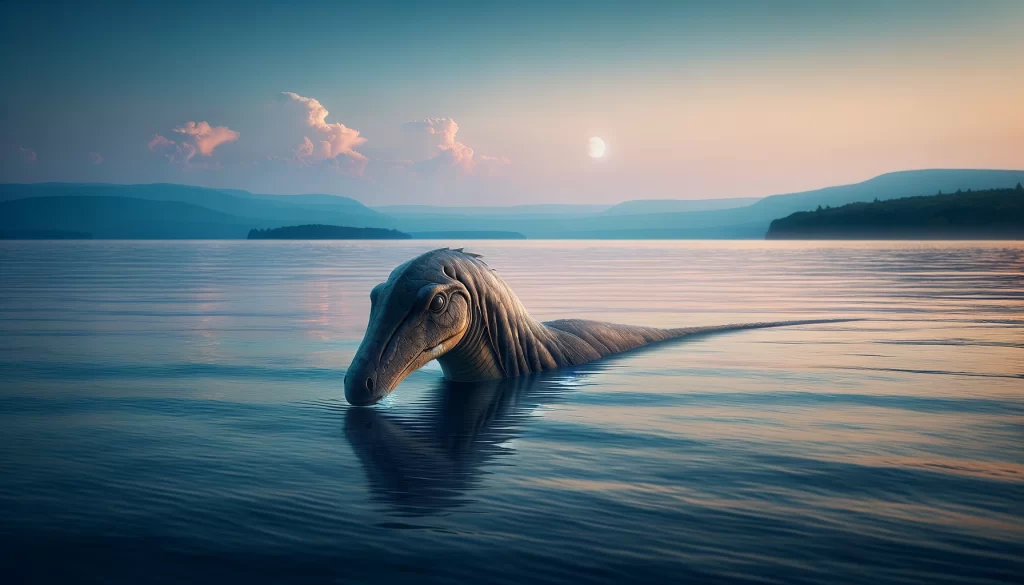
Plesiosaurs, those iconic prehistoric marine reptiles, have long captivated the human imagination, especially within the context of sea serpent legends and cryptid lore. Though not dinosaurs by strict definition, their storied presence in folklore and alleged sightings align with many a wishful thinking that these creatures might still roam the depths of our planet’s waters. Despite the lack of concrete evidence to support their existence beyond ancient fossils, the idea of living plesiosaurs has never truly faded from public fascination.
Among the myriad of water-dwelling cryptids purported to exist, Champ, the legendary inhabitant of Lake Champlain, stands out. With origins in the lore of the Abenaki and Iroquois tribes, the tales of Champ, once known as Tatoskok, have woven themselves into the fabric of local and wider folklore. Sightings surged in the 1990s, though skeptics often attribute these reports to misidentified large fish. Nevertheless, the intrigue surrounding Champ, especially following the famous photo taken by Sandra Mansi in 1977, keeps the legend alive and well.
The notion of plesiosaurs lurking in modern bodies of water extends beyond Champ. Lake Pepin, with its once-offered $50,000 bounty for proof of its own monster, and Russia’s Lake Khaiyr, with its cold-climate-surviving cryptid, are but two more chapters in the global anthology of plesiosaur-like legends. Even the Zuiyo-maru carcass, initially stirring speculations about a dead plesiosaur, was later rationalized as the decomposed remains of a basking shark, as detailed by the Reports of the National Center for Science Education.
These tales, while often met with skepticism and scientific explanations, underscore a collective yearning for the marvelous and mysterious. They reflect humanity’s enduring fascination with the possibility that remnants of a prehistoric past might somehow have persisted into the present, lurking just beneath the surface of our understanding and waiting to be discovered. The allure of plesiosaurs and their supposed sightings embodies this intersection of myth, hope, and the unexplored frontiers of our natural world.
THERE MIGHT BE A DINOSAUR STILL ALIVE TODAY IN PARTRIDGE CREEK
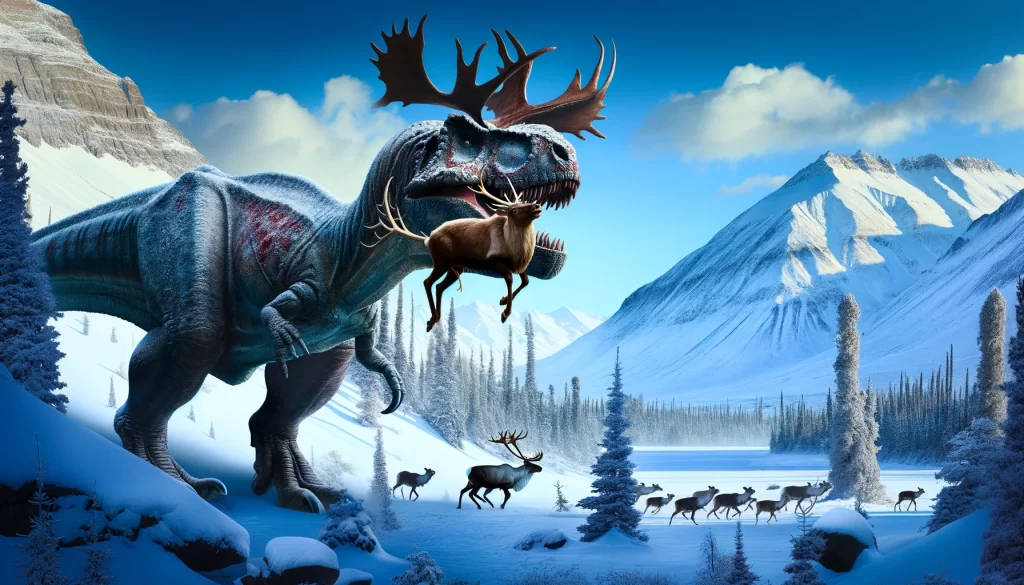
The story of Georges Dupuy and his fictional encounter with the Partridge Creek Monster serves as a cautionary tale about the power of storytelling and the enduring impact of fiction on collective belief systems. In 1908, Dupuy’s narrative of coming face-to-face with a gigantic Ceratosaurus in the snowy wilderness of Alaska captivated readers of The Strand Magazine. The inclusion of a striking image depicting the dinosaur with a caribou in its jaws only added to the tale’s vividness and intrigue.
Despite the skepticism that greeted Dupuy’s tale from the outset, the blending of a credible figure—a French-Canadian priest— with the fantastical elements of his story led to a nuanced reception among the public and even among some scientists. Naturalist Richard Lydekker, while expressing disbelief, hesitated to outright dismiss the account, highlighting the complexity of separating fact from fiction when presented by ostensibly reputable sources.
Over time, the consensus has largely settled on recognizing Dupuy’s account as a work of fiction, a creative exercise in what-if storytelling. However, the fact that some still entertain the possibility of its truth underscores the enduring allure of the unknown and the unproven in human culture. The idea that a dinosaur could survive in the harsh Alaskan climate captivates the imagination, reflecting our collective fascination with the idea that the world still holds secrets waiting to be uncovered.
Dupuy’s story, whether seen as a playful hoax or a thought-provoking piece of fiction, illustrates the intricate dance between believability and skepticism that characterizes our engagement with tales of the extraordinary. It’s a reminder that the line between myth and reality is often as captivating as the stories themselves.
OF COURSE, WE CAN’T FORGET ABOUT NESSIE
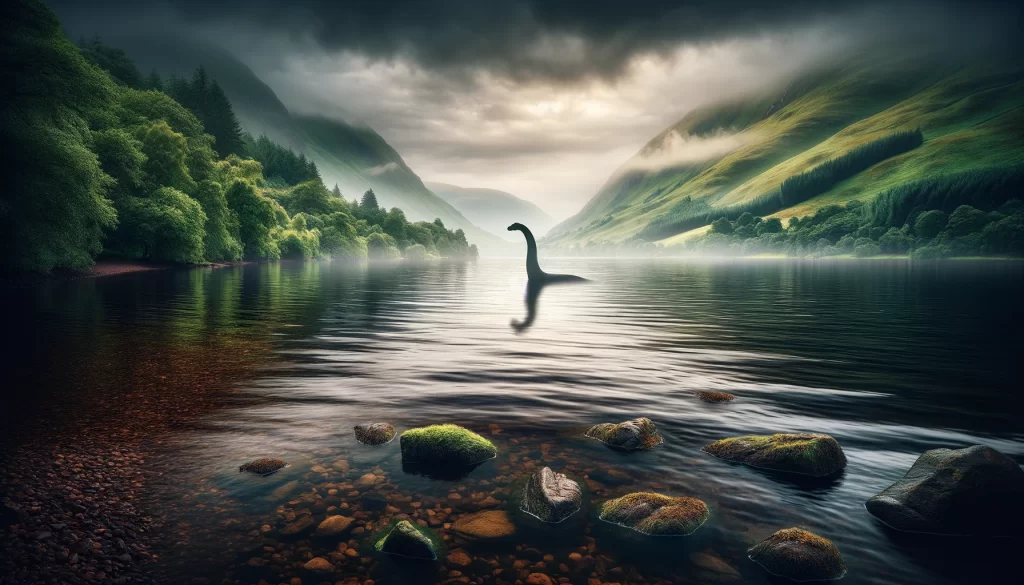
The Loch Ness Monster, affectionately known as Nessie, holds a special place in the pantheon of mythical creatures purported to still exist. With reports of its presence in Scotland’s Loch Ness stretching as far back as 565 A.D., Nessie has captivated the imaginations of locals and tourists alike for centuries. The fascination with this elusive creature reached a fever pitch in 1933 when a couple reported seeing a massive entity moving through the lake, sparking a Loch Ness mania that has lasted for decades. Despite extensive searches, including sonar and underwater photography missions, definitive proof of Nessie’s existence remains elusive, especially after the debunking of the “surgeon’s photograph” in 1994.
Yet, the lore of the Loch Ness Monster persists, fueled by a combination of hope, curiosity, and the thrill of the unknown. In 2001, the BBC reported that a government-funded natural heritage organization in Scotland had even prepared a plan for Nessie’s discovery, underscoring the creature’s significant cultural impact. Moreover, the modern era of social media has given rise to events like the “Storm Loch Ness” campaign in 2019, echoing the “Storm Area 51” phenomenon and demonstrating the enduring fascination with uncovering the truth behind legendary creatures.
In today’s unpredictable world, the legend of Nessie serves as a reminder of the mysteries that still populate our planet, waiting to be explored. The Loch Ness Monster, whether a relic of the past or a figment of collective imagination, embodies the human desire to believe in the extraordinary and the possibility that wonders may lurk just beneath the surface of our everyday lives.

